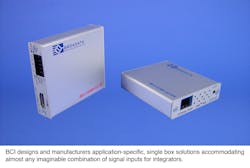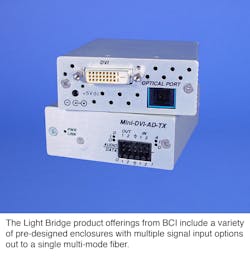Move to fiber optics leads A/V systems integrators to seek single enclosure solutions
By Jeff Elliott
Too many signals, too much hardware, and distance limitations are driving the need for single enclosure HDCP-compliant solutions out to HDMI/DVI over fiber optic cable.
Today's A/V integrators face a daunting challenge when installing complex, high definition, multimedia systems involving multiple displays and distances over 15 feet. Such installations often involve incorporating and frequently converting a myriad of signal input options to high definition formats over fiber optic cable -- and doing so with a relatively “clean” installation that minimizes potential points of failure.
Although this sounds simple enough, the reality is quite the opposite. With so many possible signal formats -- including HDMI, DVI, HD-SDI, S-video, Composite video and RGB -- the job of converting, processing and transmitting all the required inputs to HDMI or DVI over fiber optics requires a cluster of off-the-shelf extenders, converters, switches and cabling.
Further complicating matters, high definition electronics such as Blu-Ray players, satellite and cable HDTV set-top-boxes, and computers come with deeply embedded HDCP Digital Content Protection and EDID display resolution synchronization issues that must be addressed in the connections and cabling that – if not done properly – can render content unplayable. Throw in the fact that most commercial installations also require audio, USB, IR, and Ethernet connections for computer/laptop connections, and RS-232 for touch panel control systems, and AV integrators are often forced to cobble together a potpourri of off-the-shelf products together in a configuration that would make Rube Goldberg proud.
“Any of the individual components will work fine if you’re connecting Point A to Point B,” says Brad Sousa, Regional Vice President at AVI Systems, an audio-visual systems integrator based in North America. “The real challenge is when you start building more complex systems. The more source devices there are that need to be connected to a variety of displays over distance, the more messy, unorganized, and failure-prone the installation.”
This state of affairs is leading Sousa, and other top AV integrators, to seek out solutions they can standardize on that can accommodate the variety of analog and digital video, audio and computer inputs on the market while using a minimal number of enclosures. Such a solution is not only more efficient, but reduces costs while cleaning up the install.
The ability to move to fiber optics is the second part of the equation. Today, companies such as AVI Systems are moving more to fiber optics over copper or CAT5 cabling. The reason: for distances over 15 feet, copper is not recommended and CAT5 can experience signal degradation over long distances. With cable runs 50-75’ or longer for larger spaces, this can be a real issue.
“In a commercial environment, we still use both, but we tend to use fiber more than copper or CAT5,” says Sousa. “When we do defense installations, we almost exclusively use fiber optic cabling because it solves other issues as well related to classified/unclassified transmissions.”
According to Sousa, most CAT5 extenders for HDMI/DVI often amplify the signal instead of regenerating it as is the case with fiber optics. The longer the CAT5 cable and the more connections between source and display, the more the signal degrades.“With fiber optics, by the very nature of converting from an electric signal to optical and back again, you get a really, really nice signal at the end,” he explains.
After extensive research into available product offerings, Sousa discovered Broadata Communications Inc (BCI), a U.S.-based manufacturer of direct pluggable, mini enclosures and wall plates (including the first to offer Decora style) that can accept any signal input out to HDMI/DVI over a single multi-mode fiber. “BCI’s products allow us to mix and match just about any combination of video, audio and data formats to high definition,” says Sousa. “So these products become a bit of a Swiss-Army Knife for an integrator that is trying to retrofit or upgrade a system from an analog system to a new digital-based transport.”
While most off-the-shelf products in this market space are manufactured in Asia, Sousa maintains that BCI’s ability to design and manufacture high end, even custom, solutions for its customers at its U.S. facility differentiates it from the rest of the off-the-shelf fiber extender product market. What also appealed to Sousa is that BCI’s Light Bridge Technology – essentially proprietary embedded software – handles the analog to digital signal conversion without the need for a separate converter box. This reduces costs, since converter boxes are common components in such systems, and eliminates several potential points of failure.
The products also address critical HDCP interoperability issues that can occur when an install becomes increasingly complex. HDCP is a method of copy protection designed to prevent the interception of digital data while it is being transported from the source to the display. It uses authentication and a method of key exchange to keep the connection secure.
Sousa explains, however, that HDCP was initially designed to work in a one source, one display type consumer environment. "In today’s media or presentation rooms, you might find ten or more computing devices, 2-3 cable boxes, and even multiple Blu-Ray players connected to a variety of projectors, flat panels and touch screens. As the required transmitters, receivers and switches are daisy-chained together, HDCP interoperability and timing issues can cause conflicts that can render the media unplayable. The value of BCI’s product is it enables us to address the HDCP and other data protocol issues despite the number of connected source or displays."
According to Sousa, AVI Systems has standardized on off-the-shelf BCI’s units for many of its projects. At one of the U.S. government’s leading National Laboratories, for instance, the unit worked so well that it has become the standard across hundreds of offices as it rolls out collaboration systems utilizing high resolution graphics in tandem with real-time video conferencing. “We were able to build a repeatable process that speeds up difficult installations, and this has had a significant impact on our bottom line,” adds Sousa.
Another firm advocate of this approach is Kosuke Kisara, a communications engineer who is CTO of PSI Inc., a company that has been heavily involved in introducing fiber optics and multi-media transmission systems into the Japanese market over the past 15 years. PSI has been using a customized digital video converter/transmitter for HD-SDI, HDMI and DVI to ease cable TV customer’s transition from analog to digital, for security surveillance systems, digital signage, hospital operating room HD video systems, and to integrate video, audio and data communication over one pipe.
“We’ve sold 70 fiber optics systems using DVI converters to this hospital,” comments Kosuke. “Another customer purchased 30 HDMI fiber optics systems for huge video displays in train stations and department stores.” As in the case of AVI Systems, these systems were enabled via boxes designed by Broadata to eliminate multiple boxes and simplify what would otherwise have been a very challenging installation.
“BCI has been accommodating whenever we have required specific modifications or custom requirements,” adds Kosuke. “The units are competitively priced, the company is using its own patented technology and manufacturing it at its own facility. They have been responsive to our needs on quality and standards.”
For more information about Broadata Communications, contact Devan Cress, Sales Manager, 2545 W. 237th Street, Ste. K, Torrance, CA 90505, Phone: 310.530.1416 or Fax: 310.530.5958. E-mail to: [email protected]
Jeff Elliott is a Torrance, Calif.-based technical writer. He has researched and written about industrial technologies and issues for the past 15 years.


